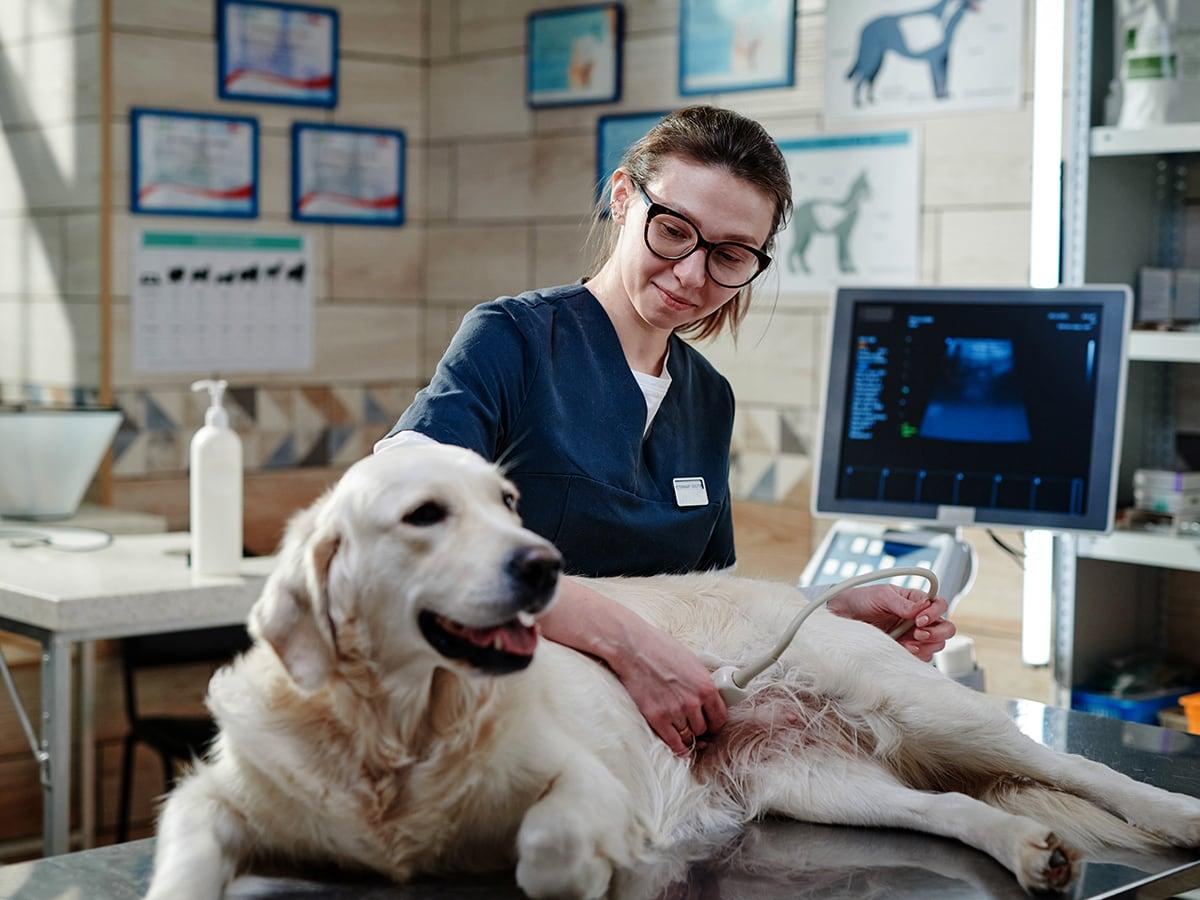Lymphoma, a cancer affecting the lymphatic system, is one of the most prevalent cancers in dogs, accounting for 7-14% of all canine cancer diagnoses4. It involves the uncontrolled growth of lymphocytes, a type of white blood cell crucial for immune function. While lymphoma can affect any organ, it often originates in lymph nodes before potentially spreading to other areas like the spleen, liver, and bone marrow.
Understanding Canine Lymphoma
There are over 30 recognized types of canine lymphoma, each varying in its behavior and aggressiveness4. Some progress rapidly and necessitate aggressive treatment, while others advance slowly and can be managed as chronic conditions. The most common type is multicentric lymphoma, which initially manifests in the lymph nodes and accounts for approximately 80% of cases4.
Recognizing the Signs: Symptoms of Lymphoma in Dogs
The symptoms of lymphoma can vary depending on the type and stage of the disease. However, the most common initial sign is the presence of firm, enlarged, and non-painful lymph nodes4. These may feel like hard, rubbery lumps under your dog's skin. Other common symptoms include4:
Lethargy or decreased energy
Loss of appetite
Weight loss
Swelling of the face or legs (edema)
Increased thirst and urination
Vomiting and/or diarrhea
Difficulty breathing
Skin lesions
It's important to note that symptoms can be subtle or even absent in the early stages, and the specific signs can vary based on the type of lymphoma.
Types of Canine Lymphoma
Multicentric lymphoma: The most prevalent form, affecting lymph nodes throughout the body, causing them to enlarge. Multicentric lymphoma may also involve organs such as the liver or spleen. It represents 80-85% of canine lymphoma cases and typically presents with generalized, non-painful swelling of lymph nodes1.
Alimentary lymphoma: Targeting the intestines, this type can lead to vomiting, diarrhea, weight loss, and abdominal pain. It accounts for less than 10% of all canine lymphoma cases1.
Mediastinal lymphoma: This rare type affects the lymph nodes in the chest, potentially causing difficulty breathing, increased thirst and urination, and swelling of the face or legs.
Extranodal lymphoma: This type affects specific organs outside the lymphatic system, such as the skin, eyes, kidneys, or central nervous system. Symptoms depend on the affected organ.
Cutaneous lymphoma: Affecting the skin, this type may cause dry, flaky, red, itchy patches or even masses and ulcers.
If you observe any concerning symptoms in your dog, consult your veterinarian promptly for evaluation and diagnosis.
Diagnosis and Staging
Lymphoma is typically diagnosed through a biopsy, a minor surgical procedure to remove a sample of the affected lymph node or organ for microscopic examination.
To determine the extent of the disease (staging), additional tests may be recommended, such as blood tests, urinalysis, X-rays, abdominal ultrasound, and bone marrow aspiration. Staging helps assess the dog's overall health and guide treatment decisions.
Treatment Options and Prognosis
Chemotherapy is the most effective treatment for most types of canine lymphoma, with an initial response rate exceeding 90%4. It often leads to remission, which can be either partial (reducing cancer by at least 50%) or complete (making the cancer undetectable)4. Most dogs experience improved quality of life and extended survival time with treatment. However, lymphoma is typically not cured, and relapse can occur. The disease may become resistant to further treatment over time.
Other treatment options, such as radiation therapy or surgery, might be considered depending on the specific type and location of the lymphoma. In some cases, palliative care may be the focus, aiming to improve the dog's quality of life and comfort.
The prognosis for dogs with lymphoma varies widely, influenced by factors like the type of lymphoma, stage at diagnosis, and chosen treatment. With a standard chemotherapy protocol, the median survival time for dogs with B-cell lymphoma is 12 months, while for T-cell lymphoma, it's 6-9 months3. Median survival means that 50% of dogs will live longer than this timeframe, and 50% will live for a shorter duration3.
Chemotherapy and its Side Effects
Chemotherapy is generally well-tolerated in dogs, with less than 25% experiencing mild side effects manageable at home and less than 5% requiring veterinary care for severe side effects3. These side effects can include temporary vomiting, diarrhea, decreased appetite, and low energy levels. Your veterinarian will provide medications and guidance to manage these side effects.
Living with Canine Lymphoma
A lymphoma diagnosis can be overwhelming, but open communication with your veterinarian is key. Discuss treatment options, potential side effects, and expectations for your dog's quality of life. Consider exploring resources like support groups or online communities to connect with other pet owners facing similar challenges.
Remember, even with a cancer diagnosis, many dogs continue to lead happy and fulfilling lives with appropriate care and management. Focus on providing your furry companion with love, comfort, and the best possible quality of life during their journey with lymphoma.
Conclusion
Lymphoma is a common but complex cancer in dogs, with various types and presentations. Recognizing potential symptoms, seeking prompt veterinary care, and understanding treatment options are crucial for navigating this challenging diagnosis.
While lymphoma is typically not curable, effective treatments like chemotherapy can offer remission and significantly improve your dog's quality of life. Treatment of high-grade, multicentric canine lymphoma with chemotherapy using a combination of drugs is often successful, with more than 90% of all dogs achieving complete remission2. With your unwavering love and support, alongside dedicated veterinary care, your canine companion can continue to experience joy and comfort even in the face of this disease.
About the Author
Dr. Jennifer Sperry, a licensed vet and Medical Director at Independence Pet Group, is dedicated to educating pet parents about the importance of pet health and financial preparedness, bringing pet health information to a broad audience.

With 10 years of experience as a pet parent, I aim to empower pet owners with insights into pet insurance and maintaining their pet's well-being. I aspire to be a trusted source, combining knowledge with a commitment to the welfare of our beloved pets.

Dr. Jennifer Sperry, a licensed vet and Medical Director at Independence Pet Group, is dedicated to educating pet parents about the importance of pet health and financial preparedness, bringing pet health information to a broad audience. You can learn more about Dr. Sperry on her LinkedIn.
Lymphoma in Dogs - Lymphoma in Dogs. (n.d.). In Merck Veterinary Manual. Retrieved September 16, 2024, from https://www.merckvetmanual.com/circulatory-system/lymphoma-in-dogs/lymphoma-in-dogs
Malignant Lymphoma in Dogs - Malignant Lymphoma in Dogs. (n.d.). In Merck Veterinary Manual. Retrieved September 16, 2024, from https://www.merckvetmanual.com/dog-owners/blood-disorders-of-dogs/malignant-lymphoma-in-dogs
Medical Oncology: Canine Multicentric Lymphoma. (n.d.). In Veterinary Hospital. Retrieved September 16, 2024, from https://hospital.cvm.ncsu.edu/services/small-animals/cancer-oncology/oncology/canine-lymphoma/
Medicine, P. V. (n.d.). Canine Lymphoma Research. In Purdue University College of Veterinary Medicine. Retrieved September 16, 2024, from https://vet.purdue.edu/wcorc/cancer-research/canine-lymphoma-research.php












